|
Education in the 19th
Century
Compared with its neighbours, Walsall
had more early educational establishments. Education was on
offer for both the poor and the better off. Education in the
town at the beginning of the 19th century is summarised in a
report produced by the Select Committee into the Education
of the Poor. |
|
The Extent of
Education in Walsall (1818)
A free grammar school founded
by Queen Mary in 1557. The headmaster receives £170
together with a house and the privilege of taking
private pupils. The funds arise from lands situate
in Walsall, Tipton and Norton, producing £400 per
annum under the management of ten governors; and in
consequence of the discovery of a coal mine under
part of the estates, which was purchased for the sum
of £12,000, to be paid into the hands of the
chancellor, by instalments of £505 per annum the
said governors obtained an Act of Parliament,
authorising them to build a chapel, of which the
headmaster for the time being was to be minister,
and the surplus of the money, after the erection, is
to be laid out in land for the benefit the above
school; and under an extension of the Act, the
governors have established a school for the
convenience of the distant hamlets; the master has
£80 per annum for his attendance at this and an
evening school, and about 264 children are
instructed under the endowment; and a school on the
same foundation as the above, is about to be
established for girls.
A Blue Coat charity school, on
the national system, for the education of 25 boys
and as many girls; 24 of the former 16 of the latter
are clothed, and there are 100 other children. The
master's salary is £80 per annum, together with a
house, arising from 4 guineas, the produce of one
acre of land at Dudley; £10 the rent of a house; £10
the interest of £200 from the corporation, and of
£70 from annual subscriptions.
A Dissenting Sunday school,
consisting of 230 children. The funds arise from
three acres of land, producing £10 per annum, out of
which the master receives £8 a year.
A school at Bloxwich, the funds
of which arise from a sum of £20 per annum, paid by
the Merchant Taylors company, to the minister of
Bloxwich for the time being, for officiating at the
chapel and school agreeable to the will of the late
William Parker, but he allows £8 per annum out of
the said stipend to the clerk to teach boys to read,
who resides in the chapel house and receives also
£25 from the parish, for teaching 25 boys writing.
Other Institutions
Five schools for boys and
girls, taught by masters, consisting of 96 of the
former and 21 of the latter; and 25 by
mistresses, in which 178 boys and 322 girls are
instructed. Also boarding schools for boys,
containing 58 scholars.
A Church Sunday school,
consisting of 383 children; one belonging to the
Calvinists, containing 316; one to the Unitarians,
24; and another to the Methodists, comprising 120.
Observations
The poor of Walsall have the
means of education, but those at Bloxwich are
without them, and very desirous that their children
should be instructed. |
|
| |
|
| Read some descriptions of
education in Walsall in the 1840s |
 |
| |
|
|
In the first half of the nineteenth
century Walsall had its grammar school, the Blue Coat
School, a number of church schools, and several private
schools, many offering an extremely basic education to the
poorer members of society, who otherwise would not even be
able to read and write. By the 1830s over 1,200 children
attended day schools in the town, and over 1,700 pupils
attended Sunday schools.
| William White's History, Gazetteer,
and Directory of Staffordshire, 1851 lists
the following academies and schools in
Walsall: Daniel
Aulton, Lower Hall Lane (boarding school)
George and Mrs. Bayley, Ablewell House
(boarding school)
Mrs. Bingham, Bradford Street
E. Brown, Lichfield Street
Miss Butler, Bradford Street
John and Mrs. Russell, Blue Coat & National,
Bridge square
Misses Andrews and Allport, British Schools,
Bridge Street
James Lowry, Catholic School, St. Mary’s
Mount
Miss Eyland, Little London (boarding school)
Miss M. Fox (infants) Windmill
Rev. J. B. Pugh, M.A., headmaster, Free
Grammar School, Lichfield Street
Edward James, Peal Street
Mary Kealing, Ablewell Street
Harriet Mason, Bradford Street
Mrs. And Miss Morris, Park Street (boarding
school)
Samuel Roberts and Miss Woodward, National
Schools, (St. Peter’s)
Jane Parkinson, Goodall Street
Carolinn Peace, Wisemore
Miss Perkins (infants), Shaw’s Leasowes
Miss Richmond, St. Mary’s Mount (boarding
school)
Jane Seaville, Littleton Street
Emma Wise, Lichfield Street (boarding
school)
Mr. Smith, Wesleyan School
Thomas Withers, George Street
Mrs. Wright, Ablewell Street |
|
By the latter half of the nineteenth
century education became more important. It was felt that
better educated young people were essential in order to
enable the country’s industries to keep ahead of the
competition, and maintain a lead in manufacturing. This
feeling lead to the passing of the 1870 Elementary Education
Act which stated that:
| The country would be divided into 2,568
school districts. In each district a School
Board would be created, consisting of members
(the number depending upon the size of the population in the
area) who were elected by local ratepayers.
School Boards were to examine the provision of
elementary education in their district and if
there were not enough school places, schools
(known as Board schools) could be built and
maintained from the rates. They could also make
their own by-laws and charge fees or let
children in free. |
The Boards were financed from the local
poor rate, or from the municipal rates, and were also
eligible to apply for capital funding in the form of a
government loan. All schools were to be inspected, and be
eligible for an annual government grant calculated on the
results of the inspection. The Act allowed women to vote for
the School Boards and serve as candidates on them. Something
that was unheard of in local government at the time.
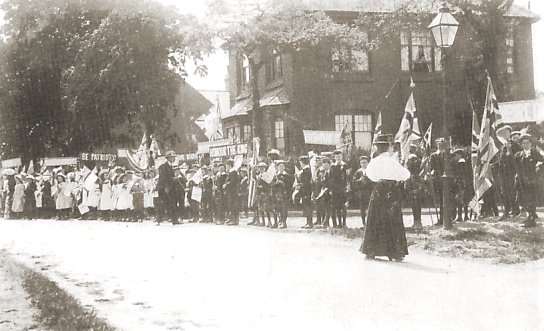
An Aldridge school march, Empire Day,
24th May, 1906. From an old postcard.
Walsall School Board was formed in
February 1871. At the time there were 5,780 places in
existing schools, but around 4,000 more were needed. In
November the Board decided to build eight schools, the first
of which would be built in areas where they were most
needed. By 1873 three of the schools had opened, the others
were completed in 1874. The Board schools were:
Bath Street, Bloxwich (Leamore), Butts,
Elmore Green, Queen Street, Tantarra Street, Wednesbury
Road, and Wisemore.
By end of the century there were eleven
Board Schools, eleven church schools, the Grammar School,
the Girls High School, and the Blue Coat School.
The Board schools
in 1904 (Kelly's Staffordshire Directory) were as follows:
| Bath Street, erected in 1875, for 230
boys, 171 girls and 180 infants. Average
attendance 210 boys, 150 girls and 120 infants. |
| The Butts, erected in 1876, for 284
boys, 250 girls. Attendance 306 boys, 250 girls
and 256 infants. |
| Tantarra Street, for 223 boys, 189
girls and 252 infants. Average attendance 231
boys, 194 girls and 225 infants. |
| Wisemore, erected in 1873, for 276
boys, 218 girls and 230 infants. Average
attendance 197 boys, 187 girls and 145 infants. |
| Wolverhampton Road, erected in 1883
and enlarged in 1893, for 330 boys, 305 girls
and 306 infants. Average attendance 328 boys,
305 girls and 316 infants. |
| Palfrey, built in 1884 at a cost,
including site, of £4,850, for 400 boys, 310
girls and 335 infants. Average attendance 448
boys, 310 girls and 347 infants. |
| Hillary Street (mixed and infants),
built in 1893 at a cost of £9,000, for 720 boys
and girls and 370 infants. Average attendance
760 boys and girls and 280 infants. |
| Croft Street (mixed and infants),
erected in 1893 and enlarged in 1899, for 840
boys and girls and 320 infants. Average
attendance 715 boys and girls 270 infants. |
| Whitehall (mixed), erected in 1899,
for 1,050 children. |
|
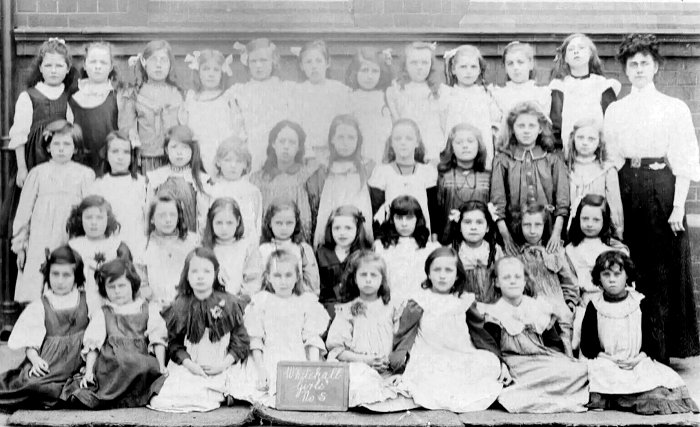
A girls' class at
Whitehall School in 1907. |
|
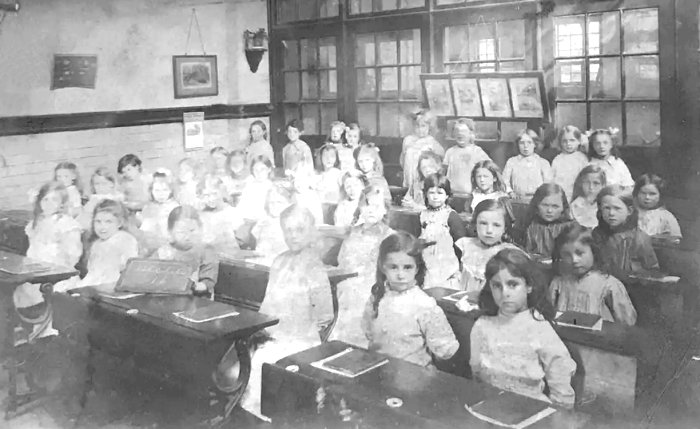
Another girls' class
at Whitehall School. |
|
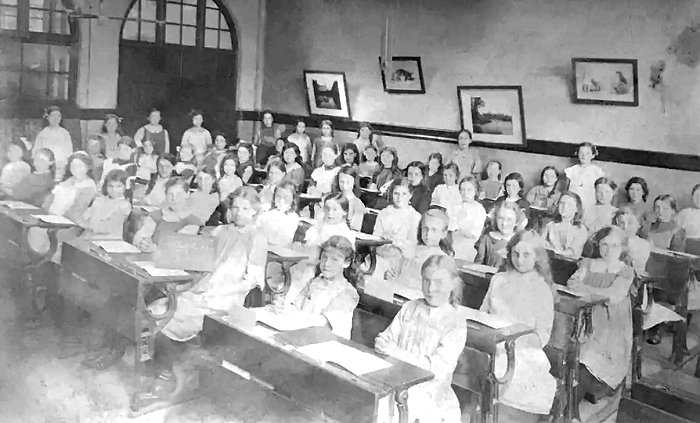
Another girls' class
at Whitehall School. |
The church schools in
1904 (Kelly's Staffordshire Directory) were as follows:
| St. John's, Pleck (mixed and
infants), erected in 1855 at an estimated cost
of £1,000, on a site given by the Earl of
Bradford, for 200 boys and girls and 110
infants. Average attendance 200 boys and girls
and 110 infants. |
| St. Matthew's, Church Hill (mixed),
erected in 1852-3 at a cost of £743, for 150
children. Average attendance 148. |
| St. Michael's, Caldmore Road, for 110
boys and 120 girls. Average attendance, 115 boys
and 118 girls. |
| St. Peter's, John Street, for 250
boys. Average attendance 230 boys. |
| St. Peter's, Whitehouse Street (girls
and infants), erected in 1872 at a cost of £1,633, and
enlarged in 1893, for 225 girls and 150 infants.
Average attendance 225 girls and 150 infants. |
| St. Peter's, Birchills (mixed and
infants), built in 1855, and enlarged in 1893
and in 1896, on a site given by the Earl of
Bradford, for 400 children. Average attendance
360. |
| St. Mary's Catholic, The Mount
(mixed), erected in about 1827, for 270 children
and 173 infants. Average attendance 206 children
and 120 infants. |
| St. Patrick's Catholic, Blue Lane
East (mixed), erected in 1863, for 400 children.
Average attendance 350. |
| St. Patrick's Catholic, Blue Lane
East (infants), erected in 1890, for 280
infants. Average attendance 266. |
| Wesleyan, Ablewell Street (mixed) for
296 children and 296 infants. Average attendance
286 children and 269 infants. |
| Wesleyan (Centenary) (mixed), John
Street, for 395 children. Average attendance
396. |
|
|
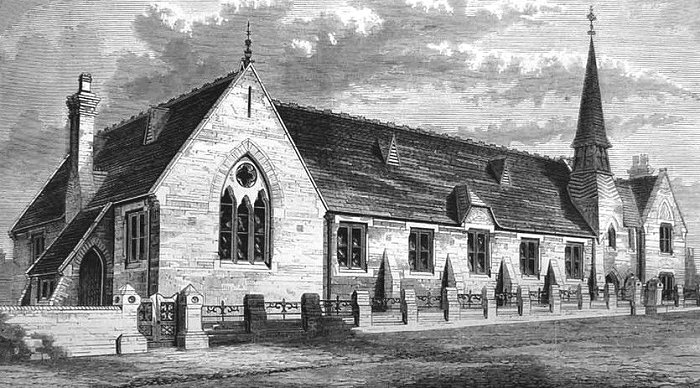
St. Peter's School, Whitehouse
Street. |
|
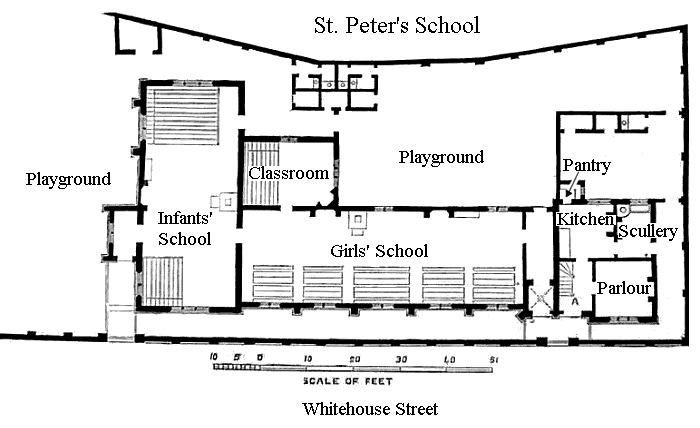
A plan of St. Peter's School. |
|
The 1870 Education Act did not make
education for children compulsory. The 1876 Royal Commission
on the Factory Acts recommended that education should be
made compulsory in order to stop child labour. A further
Education Act passed in 1880 finally made school attendance
compulsory for children between the ages of five and ten. In
1893 the age range was extended to eleven, and in 1899 to
twelve.
The Walsall School Board created a
by-law in 1872 which made school attendance compulsory, but
for many years Walsall had a terrible attendance record. In
1880 only seventy percent of children attended school, and
in the poorer districts (Bath Street, Leamore, Tantarra
Street, and Wisemore) attendance was down to between fifty
and sixty percent. School fees averaged around three pence
per week, which the poorer people could not afford. Although
they could apply for free education to the School Board,
many parents who had not been educated themselves could not
see the need for their children to be educated. They often
could not afford proper clothing for their children to wear
at school, and they could always send their children to work
instead.
| |
|
| Read a description
of a visit to Wisemore Board School in 1888 |
 |
| |
|
In 1891 the Elementary Education Act
made elementary education free, by providing grants that
were available to fund all schools. By 1900 attendance rates
had improved, because people’s attitude towards education
had changed, and the formation of a school attendance
committee.
The 1902 Education Act abolished all
School Boards. Their duties were handed over to local
authorities, which then formed education committees to
oversee education in their area. |
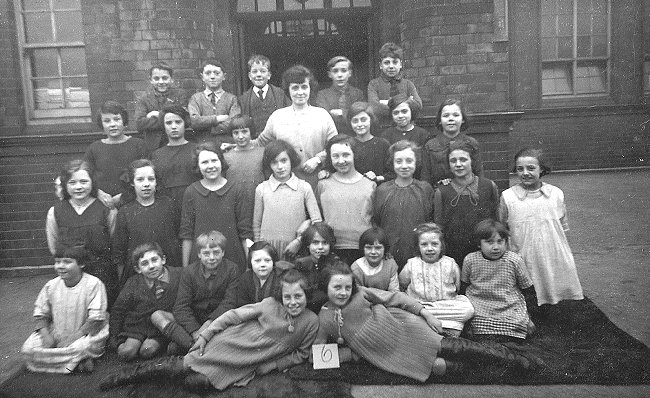
Class 6 at Tantarra Street School,
in the Chuckery. The Teacher is Miss E. P. Clayton who
married the Headmaster, Mr. Bullock. Many people might
remember has as Mrs Bullock. Courtesy of John and Christine Ashmore. |
| Queen Mary's Grammar School
In 1553 John Dudley, Lord of the Manor of Walsall was
executed for high treason, and Edward VI’s half sister Mary
came to the throne. His estates were taken over by the crown
and so Queen Mary acquired the Manor of Walsall. At that
time many of the citizens of the town felt that Walsall had
missed out, because the 1547 Chantries Act had not been
imposed there. The Act abolished the 2,374 chantries and
guild chapels. Their buildings and lands were sold, and some
of the money raised was used for the good of the public (as
stated in the Act). In several places schools were built on
chantry land.
A petition from the town, asking for
the Act to be enforced in Walsall, was taken to the Queen by
Nicholas and George Hawe. Queen Mary granted their wish, and
‘The Free Grammar School of Queen Mary’ was founded in the
town in 1554, and given some of the chantry lands. It was
built on Church Hill next to the churchyard.
The school moved to Park Street after
purchasing a house with a garden, a warehouse, and other
buildings in 1813. The asking price was £2,750. They were
converted at a cost of £940 into two school buildings, and
houses for the master and usher of the grammar school.
In 1850 the school moved to new
premises in Lichfield Street after the South Staffordshire
Railway made an unmissable offer of £3,000 for the Park
Street site.
| |
|
| Read a description
of the school from 1851 |
 |
| |
|
|
|
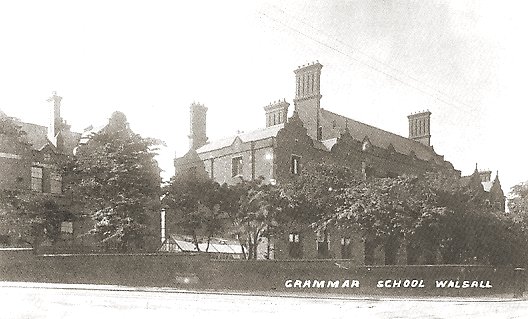
A view from around 1909. From an old
postcard. |
Land was purchased in Lichfield Street from
Lord Hatherton at a cost of £965.7s.6d. and a new school was
built at a cost of £5,107.19s.10d. It was designed by
Edward Adams, and built of brick with stone facings for
doors, windows and quoins.
It could accommodate 150 boys. |
|
Other buildings included a headmaster’s
house with a dining room, drawing room, study, and five
bedrooms; a second master’s house; a commercial master’s
house; a boys’ dormitory; two playgrounds; a porter’s lodge;
and a stable and coach house. The new school opened on 9th
April, 1850.
In 1873 the main school became The High
School, and the Commercial School became The Lower School.
In 1893 the two schools were reunited and called The High
School for Boys. In the same year the governors opened Queen
Mary's High School for Girls in Upper Forster Street,
adjoining the buildings in Lichfield Street.
In order to fit the school into the new
framework of the Local Education Authorities and the Board
of Education, The High School became Queen Mary's Grammar
School in 1909.
The school buildings in Lichfield
Street were extended in 1921 to cater for students who
intended to become school teachers. They were sent to the
school by both Walsall and the County Education Committees.
|
|

Queen Mary's Grammar School in the
late 1960s. Courtesy of the late Will Parker. |
In 1944 the school became a Voluntary
Aided grammar school with entry via the new 11 plus
examination.
In the 1950s pupil numbers grew, and in 1961
building work started on the current school in Mayfield.
It
was officially opened in 1966 by the Dean of Westminster.
The old school buildings in Lichfield Street were taken over
by the Girls' High School.
|
|
The Blue Coat School
The school was founded in the late 17th
century to provide free education for children from poor
families. The school derives its name from the colour of the
school uniform. It began life in the High Cross, also known
as High Cross House that was built in 1691 on the site of
the old market cross at the top of High Street and remained
there until the building was demolished in 1800. There were
initially 24 boys and 16 girls.
The school then moved to a house on The
Bridge which had been purchased by the trustees. It
consisted of a single schoolroom with a teacher's house
attached. By 1819 a
second story had been added so that the building could
accommodate 140 boys and 160 girls. Free education was
provided for 25 boys and 25 girls. In 1820 the school
merged with the recently formed National School. The
building was rebuilt in 1826 and greatly enlarged. It could
then accommodate 228 girls and 228 boys. The fee-paying
children paid one penny a week.
|
| In 1859 the school moved to a larger building in St.
Paul's Close. It was designed by Henry Cooper of London and
had rooms for boys and girls, and houses for a master and
mistress.
There was also a large domestic science room for the girls,
with a wash house where laundering could be taught. The cost
of the development was met by subscriptions, gifts, a
government grant, and the sale of land at Dudley, and the
sale of the old site.
|
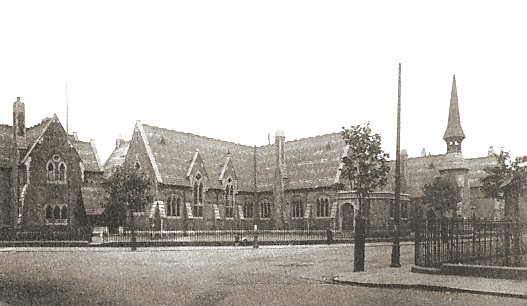
The Blue Coat School in St. Paul's
Close. From an old postcard. |
| In 1884 the school began to take older pupils from St.
Matthew's Church of England School, and in 1891 as a result
of the Elementary Education Act, fees were abolished for the
younger children. In 1933 the school’s building was
purchased by the council in readiness for the town’s central
bus station. The senior school then moved to Springhill
Road, the junior school moved to the vicarage in Hanch
place, and the infants moved into the council’s Bath Street
school building. |
|
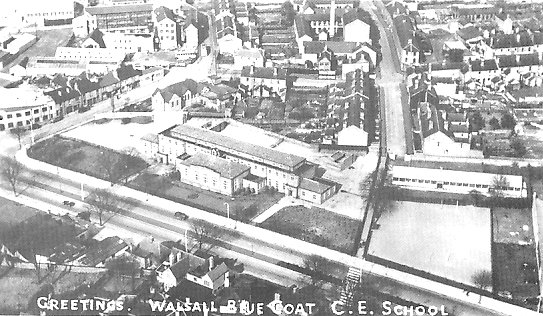
Blue Coat School in Springhill Road.
From an old postcard. |
In 1953 the governors decided to retain
voluntary aided status and to provide new buildings for the
senior school, which in 1965 moved to a new building in
Birmingham Street.
The juniors moved into new premises on
Springhill Road and the infants moved to Hanch Place. |
|
In 1972 the
secondary school was expanded to form a larger comprehensive
school with its own sixth form, and the former Chuckery
council school in Lincoln Road became an annexe. Over the next two years the
Birmingham Street site was extended.

The Blue Coat School. From an old
postcard, courtesy of Christine and John Ashmore.

Another view of the Blue Coat School.

A letterhead from the 1970s.
St. Matthew's Church of
England School
The school was established in 1853 on a
site at the east end of St. Mathew's Church that was given
by Lord Bradford. The school building consisted of a single
classroom with accommodation for 150 children, and a
teacher's house. In 1855 one hundred children attended the
school, each paying two pence per week. As already
mentioned, in 1884 the school worked in conjunction with the
Blue Coat School, and became the
Blue Coat Infants school in 1906.
St. Andrew's Church of
England Junior and Infants' School
In 1855 the managers of St. Peter's
National Schools opened a branch school in Hollyhedge Lane,
Birchills, known as Birchills National School, built with
the aid of grants from the government and the National
Society. It catered for eighty fee-paying children. In the
late 1880s it was also used as a mission church until the
consecration of St. Andrew's Church in 1887. Three years
later it was taken over, and enlarged by the church. In the
1930s it became a junior mixed infants school.
St. Patrick's Roman
Catholic Junior and Infants' School
The school opened in 1859 in a school
room behind St. Patrick's Church in Blue Lane East. It
catered for 170 children, some of whom received free
education. In 1864 it was extended with the addition of a
separate room for infants, and in 1902 a new infants' school
opened. After 1963 the senior pupils moved to the newly
opened Francis Martyn Roman Catholic High School, and in
1967 the school moved into new buildings in Blue Lane East.
Caldmore Church of
England School
In 1867 a school for boys, girls, and
infants, with a teacher's house attached, opened on the
corner of Caldmore Road and St. Michael Street. The running
of the school was taken over by the newly formed parish of
St. Michael and All Angels in 1872. It later became a junior
mixed and infants' school, and closed in 1959.
Wednesbury Road
Congregational School
The school, attached to the
Congregational chapel in Wednesbury Road had opened by 1869.
By 1876 the weekday and Sunday school catered for 476
children, but soon ran into financial difficulties. In 1880
it became the Wednesbury Road Board School, and continued as
such until 1884 when Palfrey Board School opened. In 1902 it
was taken over by the council, and run until 1905.
Pleck Church of England
School
It opened in 1825 as a National School
to provide cheap education for around 60 children from the
Pleck area, between the ages of 7 and 13. There was a single
schoolroom, and a school mistress. Children were charged two
pence a week. The schoolroom soon became inadequate because
of the rapidly rising population in Pleck, and in 1855 a new
larger school was built in Pleck Road, on land given by Lord
Bradford. The new school, which opened in 1856, catered for
54 boys and 46 girls, and was also used for church services
until St. John's Church opened in 1858. Thanks to a
government grant, the school was enlarged in 1867 to provide
separate rooms for boys and girls, and remained as such
until 1930 when it became an infants only school. The school
closed in 1962.
Bloxwich Church of
England Junior and Infants School
The school was founded in 1616 thanks
to a bequest by William Parker, a successful London merchant
taylor whose home town was Bloxwich. In his will he left
land to the Merchant Taylors' Company. The proceeds from
which were to provide an annual salary of twenty pounds for
the minister of Bloxwich Chapel, on condition that he should
teach boys who live in Bloxwich, Harden and parts of the
surrounding area to read. This was to be done without
charge, either in the chapel, or the minister’s house.
This continued until the early
nineteenth century when the minister paid a master, who was
also the chapel clerk, eight pounds a year to teach the
boys. The children were taught in the minister’s house,
where the clerk lived rent free.
In 1826 John Baylie became the minister
and decided to occupy the minister’s house instead of the
clerk. The school then became a Sunday school until 1828
when Baylie reopened the school as a National School for
boys and girls at the northern end of Bloxwich High Street.
National Schools were Church of England schools, established
in the nineteenth century by the National Society in England
and Wales.
|
| By 1833 there were 108 boys and 70
girls in attendance.
On Sundays it became a Sunday school
with 140 boys and 80 girls.
The fees were one penny or two
pence per week, but the school continued to provide free
education to fifteen boys, as specified in William Parker’s
will. |
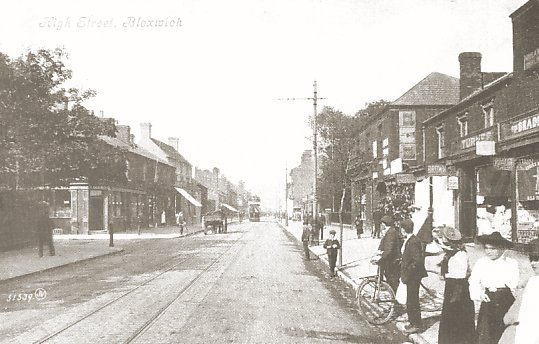
Bloxwich High Street. From an old
postcard. |
| In the mid 1840s the building was
extended, and a teacher’s house was built. The school was
rebuilt in 1862 and enlarged at the turn of the century. In
the 1930s it became Bloxwich Church of England School, with
departments for senior mixed pupils, junior mixed pupils,
and infants. As a result of the 1944 Education Act the
senior school became a secondary modern school, which closed
in 1974 and was taken over by the junior school. |
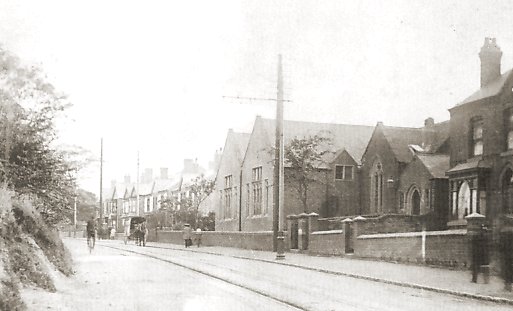
Rushall School in around 1908. From an old
postcard.
|
Christ Church Junior and
Infants' School
The school opened at Blakenall Heath as
a branch of the National School at Bloxwich, in 1843. It was
also used as a mission
church, and opened thanks to the efforts of the minister, John Baylie. The school catered for 40 boys and 44 girls on
weekdays, and 60 boys and 44 girls on Sundays. The buildings
were enlarged in 1861, and older children were admitted. The
school ceased to be used for worship when Christ Church
opened in 1870, and three years later the church took charge
of the school. Further building work took place in 1928, and
the school became a junior mixed and infants' school. In
1971 the school moved to new buildings off Harden Road.
Elmore Green Junior and Infants' School
The school, situated in Elmore Green
Road, Bloxwich, opened in 1882 as a mixed and infants' board
school. The school was extended in 1904 with the addition of
a building to house the junior mixed school. In 1906 the
school became a junior mixed and infants school, and an upper-standard school,
which became a higher elementary school in 1908, and a selective
central school in 1922-3, offering commercial and
academic courses.
In 1944 it became Elmore Green High School,
and provided grammar, commercial, and
technical courses. In 1958 the pupils and staff moved to
new premises in Lichfield Road, Bloxwich, to form part of the T. P.
Riley Comprehensive School, itself now replaced by Walsall
Academy. The school is now Elmore Green Primary School.
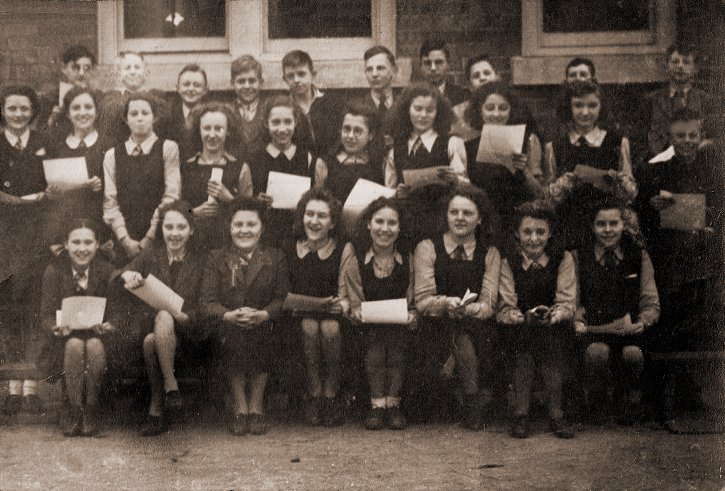
Form 3.6 Elmore Green High School.
Courtesy of Jon Owen.
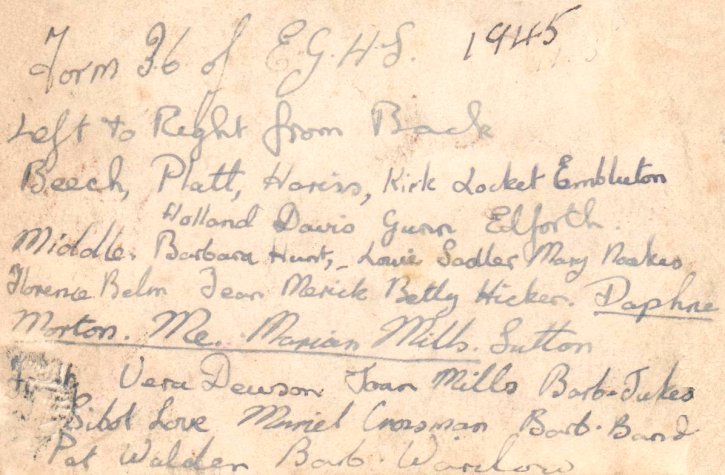
Form 3.6 Elmore Green High School.
Courtesy of Jon Owen.
Leamore Junior and Infants School
The school opened in Bloxwich
Road in 1873 as a board school for boys, girls, and
infants. The boys section closed in 1916 due to a shortage of
teachers. After the war in 1919 the school was reorganised.
The ex-boys section was taken-over by the girls, the infants
moved into the vacated girls building, and the old infants
building became a domestic science centre, which closed in
1925 when a domestic science centre opened in Field Street
School. In 1929 it became a junior and mixed infants school.
It is now Leamore Primary School.
St. Peter's Roman Catholic Primary School
The school opened in 1825 as St. Thomas's Roman Catholic
School, in a small schoolroom next to St. Thomas the Apostle
Chapel in Harden Road (previously Harden Lane). It catered
for around 56 pupils on weekdays, and 76 on Sundays.
Children from better-off families were charged one penny a
week, and taught to read. Pupils were taught to write for an
extra penny a week, and taught arithmetic for
another penny. In 1869 St. Thomas's Chapel closed when
St. Peter's Church opened in Bloxwich High Street. A year
later the school moved to new buildings in Harrison Street
behind the new church, and became St. Peter's Catholic
School, catering for 65 fee-paying pupils. In 1899 the
school was enlarged, and in 1963 the senior pupils moved to
the newly opened Francis Martyn Roman Catholic High School in
Dartmouth Avenue. The school moved to its present site in
Lichfield Road, Bloxwich in 1972.
The Francis Martyn Roman Catholic High School closed in
1973 and was taken over as an annexe by St. Thomas More
Catholic School, Willenhall. The Dartmouth Avenue site
closed in about 1990 and was demolished.
The Dissenting Charity School
In the late 18th century, the Dissenters School Charity
ran a Sunday school at the Presbyterian meeting house in
Bank Court, High Street, which by that time had become
Unitarian. By the early 19th century around thirty children
were taught reading and writing on Sundays without charge, and writing
lessons were held on weekday evenings. Seventy children
regularly attended the Sunday School.
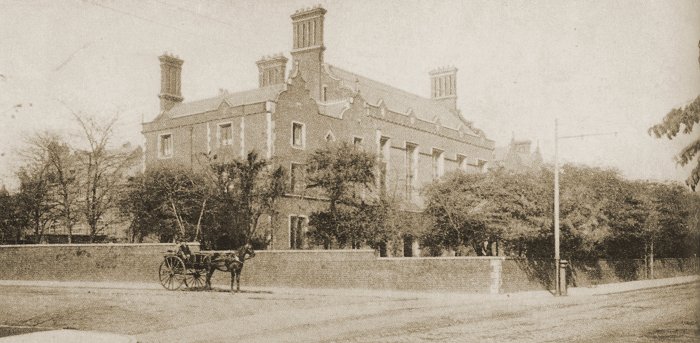
Another view of the old Queen Mary's
Grammar School.
The Ragged School
Ragged schools were established in the
1840s and 1850s to provide free education to children from
the poorest families. They were run by charitable groups who
used almost any kind of available building for their
classes. The teachers, who were usually volunteers, taught
reading, writing, arithmetic, and bible study. The Ragged
Schools Union, founded in 1844 helped to provide free
education, food, clothing, and lodging for destitute
children.
A ragged school was established in Pig
Lane, Walsall in the late 1840s, which moved to Townend Bank
in 1849 or 1850. Sadly it had a very short life because the
teachers felt that the extreme smell of the children was
damaging their health.
Croft Street Junior and Infants' School
The school opened in Birchills in 1894 as a mixed and
infants' board school. The building was enlarged in 1899,
and in 1923 divided into separate boys and girls sections.
Six years later the school was again divided, this time into
junior mixed and senior girls sections. The senior girls
section became a girls' secondary modern school in 1944. The
school closed in 1965.
Joseph Leckie School The school,
based in Walstead Road West, the
Delves, opened in 1939 as a senior school for boys, and a senior
school for
girls. They were combined in 1947 to
form a bilateral secondary school, the first of its kind in the
country, an early form of comprehensive school. The school
was extended in 1972 when the school became fully
comprehensive. It is now an academy. Edward Shelley School
The school opened in 1930 in Scarborough Road, Pleck, as a junior school, and a selective central
school specialising in technical education. In 1944 it became a
technical high school, which became part of the Wilfred
Clarke Comprehensive School in 1971, the junior school
having closed in 1958. Wolverhampton Road Board School
The school opened in 1883 and catered for boys, girls,
and infants. The school was extended in 1901 and 1906, and
in 1929 was divided into four departments: senior boys,
senior girls, junior mixed, and infants. In 1944 the senior
departments became a secondary modern school, which survived
until 1971. The junior and infants school closed in 1967.
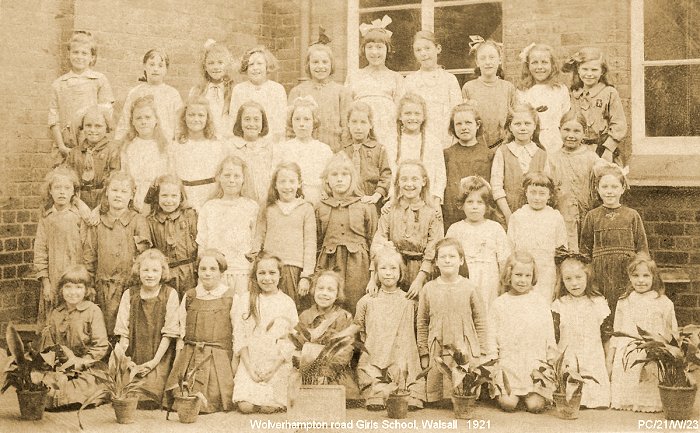
Courtesy of David Clare.
Hillary Street Junior and Infants School
The school opened in 1893 in Hillary Street, Pleck as a
mixed and infants board school. It was extended in 1906,
with the addition of a higher elementary section which
became a mixed secondary modern in 1944. This part closed in
1971, but the junior and infants section remained open and
is now Hillary Primary School. Alumwell
Junior & Infants School The school opened in 1951
in Primley Avenue as an infants school. Three years later
the junior section was added. It is still there today.
West Walsall E-ACT Academy The
school opened in 1971 as the Wilfred Clark Comprehensive
School, formed by the amalgamation of four secondary modern
schools. It was the first school in Walsall to incorporate a
community centre running out of school hours. In September
1974 it became the Alumwell Comprehensive School, then the
Alumwell Business and Enterprise College, and in September
2012 the Walsall E-ACT Academy, after gaining Academy status.
Other Church Schools There were also
many other day and Sunday schools run by local churches
including Whittimere Street School, founded by the Methodist
Free Church; Stafford Street day school which opened at
the Centenary Wesleyan Methodist Chapel; St. Mary's Roman
Catholic Junior and Infants' School, which was opened in
Vicarage Place by St. Mary's Chapel; St. Peter's Church of
England Junior and Infants School, which opened in John
Street; and Ablewell Street Wesley School built in Forster
Street by
the Ablewell
Street Chapel.
Outdoor Education In 1926 the Walsall Schoolchildren Holiday Camp
Trust purchased a site in Streetly for use as a campsite for Walsall
schoolchildren. The site was sold in 1960. Nine years later the
trust purchased a house and ten acres of land just outside
Llangollen, and in partnership with Walsall Council opened it as
Bryntysilio Outdoor Education Centre, to provide courses of outdoor
education to school groups from Walsall. Today the centre also runs
one-day courses, and provides a base for conferences and individual
groups. Today there are 128 schools in Walsall LEA, consisting of
87 primary schools, 21 secondary schools, 8
nurseries, 7 special schools, and 1 FE college. |
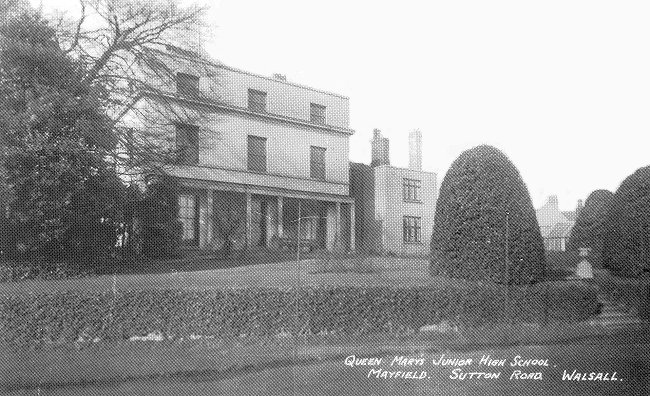
Mayfield House, Sutton Road,
Walsall. Purchased by Queen Mary's Grammar School in
1924. Now Mayfield Preparatory School. From an old
postcard. |
 |
Return to
the
previous page |
|